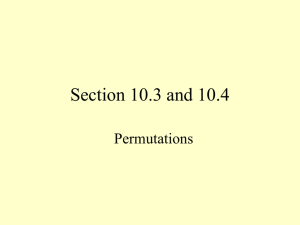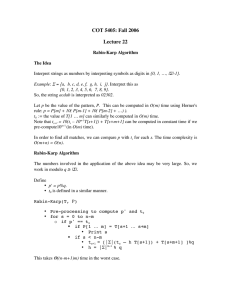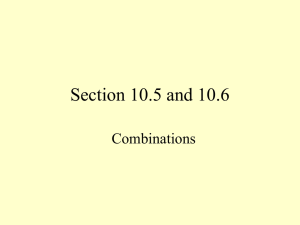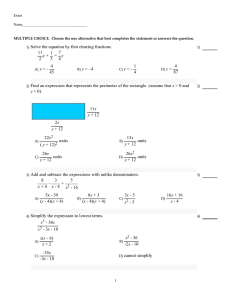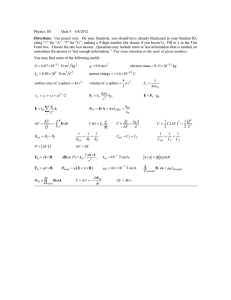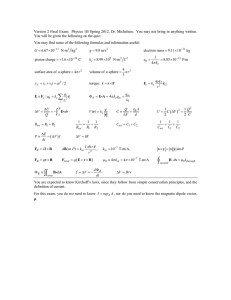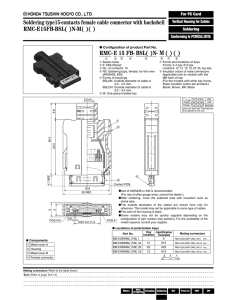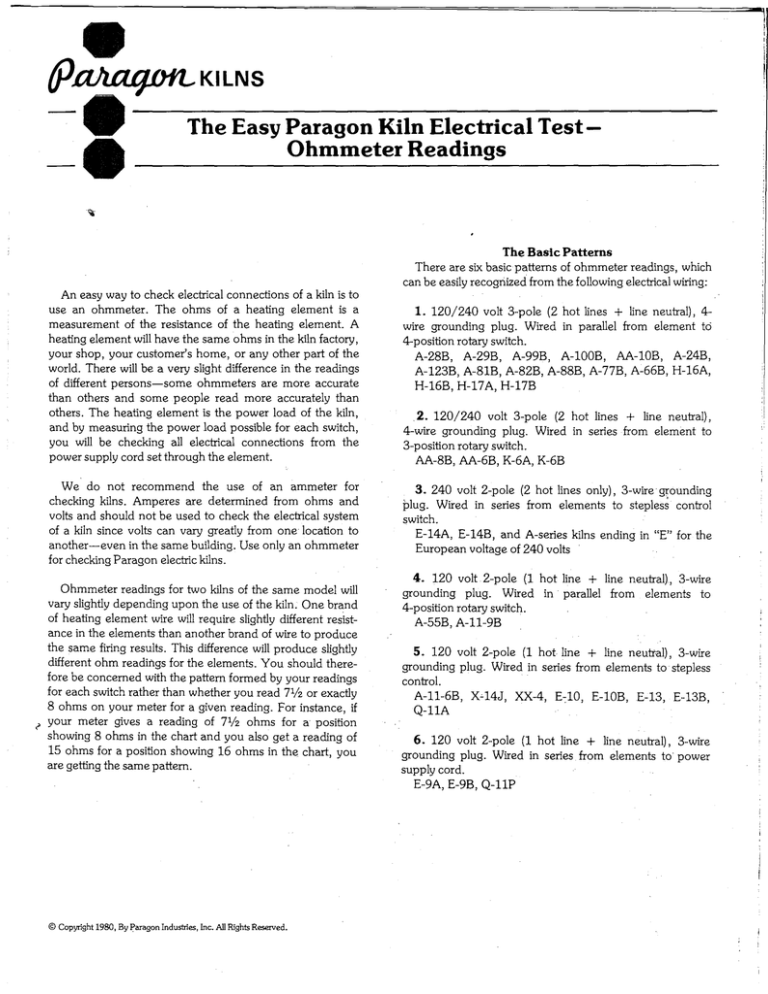
The Easy Paragon Kiln Electrical TestOhmmeter Readings
The Basic Patterns
There are six basic patterns of ohmmeter readings, which
can be easily recogriized from the following electrical wiring:
An easy way to check electrical connections of a kiln is to
use an ohmmeter. The ohms of a heating element is a
measurement of the resistance of the heating element. A
heating element will have the same ohms in the kiln factory,
your shop, your customer's home, or any other part of the
world. There will be a very slight difference in the readings
of different persons-some ohmmeters are more accurate
than others and some people read more accurately than
others. The heating element is the power load of the kiln,
and by measuring the power load possible for each switch,
you will be checking all electrical connections from the
power supply cord set through the element.
We do not recommend the use of an ammeter for
checking kilns. Amperes are determined from ohms and
volts and should not be used to check the electrical system
of a kiln since volts can vary greatly from one location to
another-even in the same building. Use only an ohmmeter
for checking Paragon electric kilns.
~
Ohmmeter readings for two kilns of the same model will
vary slightly depending upon the use of the kiln. One brand
of heating element wire will require slightly different resistance in the elements than another brand of wire to produce
the same firing results. This difference will produce slightly
different ohm readings for the elements. You should therefore be concerned with the pattern formed by your readings
for each switch rather than whether you read 71/2 or exactly
8 ohms on your meter for a given reading. For instance, if
your meter gives a reading of 71/2 ohms for a position
showing S ohms in the chart and you also get a reading of
15 ohms for a position showing 16 ohms in the chart, you
are getting the same pattern.
© Copyright 1980, By Paragon Industries, Inc. All Rights Reserved.
1. 120/240 volt 3-pole (2 hot lines + line neutral), 4wire grounding plug. Wired in parallel from element t6
4-position rotary switch.
A-28B, A-29B, A-99B, A-lOOB, AA-10B, A-24B,
A-123B, A-S1B, A-S2B, A-SSB, A-77B, A-66B, H-16A,
H-16B, H-17A, H-17B
2. 120/240 volt 3-pole (2 hot lines + line neutral),
4-wire grounding plug. Wired in series from element to
3-position rotary switch.
AA-SB, AA-6B, K-6A, K-6B
3. 240 volt 2-pole (2 hot lines only), 3-wire· grounding
plug. Wired in series from elements to steples~ control
switch.
E-14A, E-14B, and A-series kilns ending in "E" for the
European voltage of 240 volts
4. 120 volt 2-pole (1 hot line + line neutral), 3-wire
grounding plug. Wired in parallel from elements to
4-position rotary switch.
A-55B, A-1l-9B
5. 120 volt 2-pole (1 hot line + line neuttal), 3-wire
grounding plug. Wired in series from elements to stepless
control.
A-1l-6B, X~14J, XX-4, E~10, E-10B, E-13, E-13B,
Q-llA
6. 120 volt 2-pole (1 hot line + line neutral), 3-wire
grounding plug. Wired in series from elements to· power
supply cord.
E-9A, E-9B, Q-llP
The Ohmmeter Reading
1. Unplug the power supply cord set arid place it in a
position that allows the blades of the attachment cap to be
easily reached by the leads of the ohmmeter.
4. Check meter and the connections of meter leads by
measuring the ohms of the 10 ohm resistor attached to one
lead. This meter check is to be made only after the meter is
in position to be read.
2. If the kiln is equipped with a limit timer, set clock for
one hour before operating the kiln sitter. If the kiln has a kiln
sitter, raise the weight, press in the plunger, and then gently
lower the weight so that the kiln sitter is on manual control.
5. Touch one lead of the meter to the grounding blade
(round shape) of the power supply cap and the other lead to
the kiln jacket to give 0 ohms reading.
6. Touch one lead of meter to the grounding blade of the
attachment cap and the other lead to the line neutral
terminal of the attachment cap. This will result in NO
MOVEMENT (N-M) of the ohmmeter needle.
3. Turn all kiln switches to OFF position. Only one (1)
switch is to be checked during a reading. Be certain to leave
each switch in the OFF position after reading has been
made.
Repeat steps 1 through 6 each time the meter is
moved.
Ohmmeter Reading Chart
Model or
Section
of kiln •
Switch
Position
Step 7
One Hot
to Neutral
StepS
Other Hot
to Neutral
Step 9
Hot to Hot
A-99B
Top or Center
Switch
Hi~h
Med
Low
8
8
16
8
N-M"
N-M
16
N-M
N-M
A-99B
Bottom
Switch
High
Med
Low
7
7
14
7
N-M
N-M
14
N-M
N-M
A-S2B
Either
Switch
High
Med
Low
8
8
16
8
N-M
N-M
16
N-M
N-M
A-SSB
Either
Switch
High
Med
Low
9%
9%
18112
9%
N-M
N-M
181/2
N-M
N-M
A-77B
Either
Switch
High
Med
Low
13
13
26
13
N-M
N-M
26
N-M
N-M
A-66B
Hiqh
Med
Low
7112
7112
7112
15
N-M
N-M
High
Med
Low
6
12
24
A-55B
15
N-M
N-M
(Steps 8 & 9 do not apply
to a 120 volt kiln.)
'Kilns with same Replacement Element Part Number have same readings.
"N-M indicates no movement of the ohmmeter needle.
Notes
Switch
Position
Step 7
One Hot
to Neutral
Step 8
Other Hot
to Neutral
Step 9
Hot to Hot
AA-8B
High
Low
N-M
29
N-M
N-M
29
N-M
AA-6B
High
Low
N-M
36
N-M
N-M
36
N-M
A-11-6B
High
Med (3)
Low
8
8
8
E-14A
High
Med(3)
Low
(Steps 7 & 8 do not
apply to a 2-pole,
240 volt kiln.)
X-14J
High
Med (3)
Low
8
8
8
Plug In
10
Model or
Section
of Kiln
Q-IIP
(Steps 8 & 9 do not apply
to a 120 volt kiln.)
20
20
20
(Steps 8 & 9 do not apply
to a 120 volt kiln.)
Notes
How to Test a Wall Receptacle with a Voltmeter
With all due respect, electricians who have not studied
changes established in 1965 will often make serious errors in
connections of the nominal 120/240 volt wall receptacles.
The wire connections on receptacles that are marked "W"
from 1965 onward are the same connections that were
marked "G" prior to 1965. This connection of the line
neutral wire must be properly made in the circuit that
provides the electrical power. Failure to make the
connection properly can greatly shorten the life expectancy
of the elements and the switch(es) of your kiln. Please refer
below to the NEMA Configurations and connection
markings of receptacles manufactured after 1965.
~
~
20 Amps.
125/250V
~ ~
~ ~
. 30 Amps.
125/250V
50 Amps.
125/250V
~
YO
G
~
Ox
30 Amps.
125/250V
D~'131@318"@2l/~21116'
50 Amps.
125/250V
20 Amps.
125/250V
60 Amps.
125/250V
DIA. 23/8"
DIA.13/8"
DIA. 23/8"
1. With probes of voltmeter in "W" and "Y", voltage
should measure NOT LESS than 104 volts and NOT MORE
than 130 volts.
2. With probes of voltmeter in "W" and "X", voltage
should measure NOT LESS than 104 volts and NOT MORE
than 130 volts.
3. With probes of voltmeter ih"Y" and "X", voltage should
measure between 208 and 240 volts. Very near the total
voltage in steps 1 and 2.
4. Voltage from "G" and "W" should be 0 volts as proof
that NEITHER "hof' wire is connected to "G" or "W". 0
volts is NOT proof that the line NEUTRAL wire is properly
connected as it must be for correct firing and long life.
Adapting WYE or Delta Three-Phase
Power Supply to the Required 120/240
Volt, 3-Pole, Single-Phase
Grounded Connection with a Separate
EqUipment Bond
The 120/208 volt WYE system (often called 208 volt,
three-phase) has three hot poles of EQUAL voltage and a
line neutral pole for a total of four poles in the system. To
install the required 208 volt, single-phase, 3-pole line neu- .
tral circuit for kiln operation, the electrician would need to
pull any two of the three hot poles and the one line neutral
pole of the single-phase circuit with line neutral to be terminated in a standard circuit breaker box. Since all hot poles
in the WYE system are equal, the electrician does not need
to be concerned as to which two of the three hot poles are
used, but he does need to be concerned that the line neutral pole is properly connected and that the line neutral pole
is NOT confused with the third hot pole, which will not be
used in the kiln circuit.
The 120/240 volt DELTA system of three-phase power
requires more care on the part of the electrician. The
DELTA system has three hot poles of UNEQUAL voltage
and a line neutral wire for a total of four poles in the system.
From the DELTA system the electrician also uses two hot
poles, but he MUST be sure that each of the two hot poles
does NOT measure more than 130 volts to ground. These
two hot poles and the line neutral pole makeup the singlephase, 3-pole line neutral circuit, which will be terminated in
the standard circuit breaker box. If the hot pole that
measures more than 130 volts to ground is used in the kiln
circuit, the kiln will have very short element life, switch
problems, and other problems until the error is corrected.
WARNING: The grounding (round blade)
connection must be separate and apart from the line
neutral connection. The proper function of the line
neutral is altered if a connection is made between
the line neutral and the grounding or bonding
connection.
LEADING
MANUFACTURER
OF ELECTRIC
CERAMIC
KILNS
INDUSTRIES, INC.
BOX 10133
DALLAS, TEXAS 75207
IM-20

